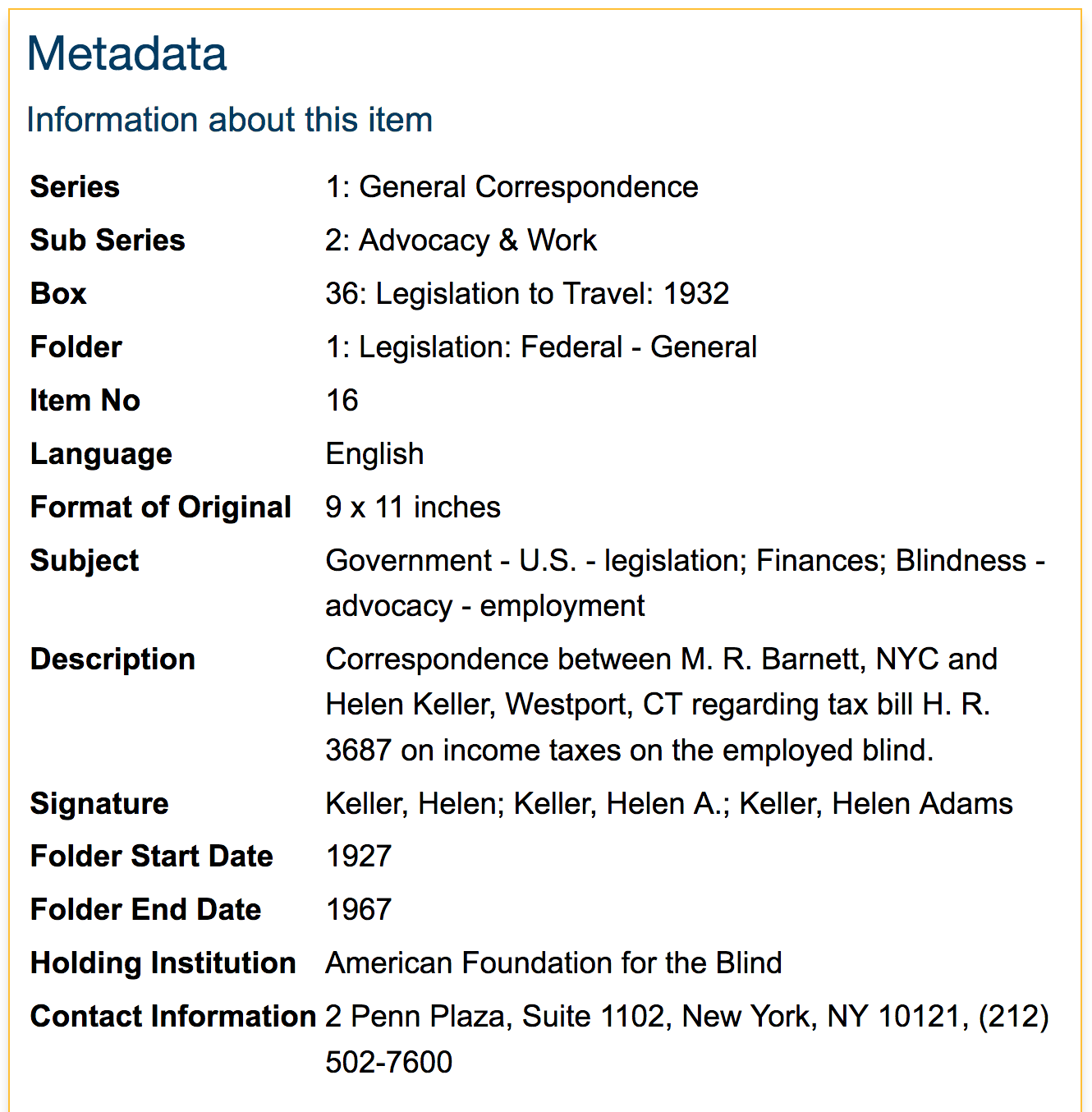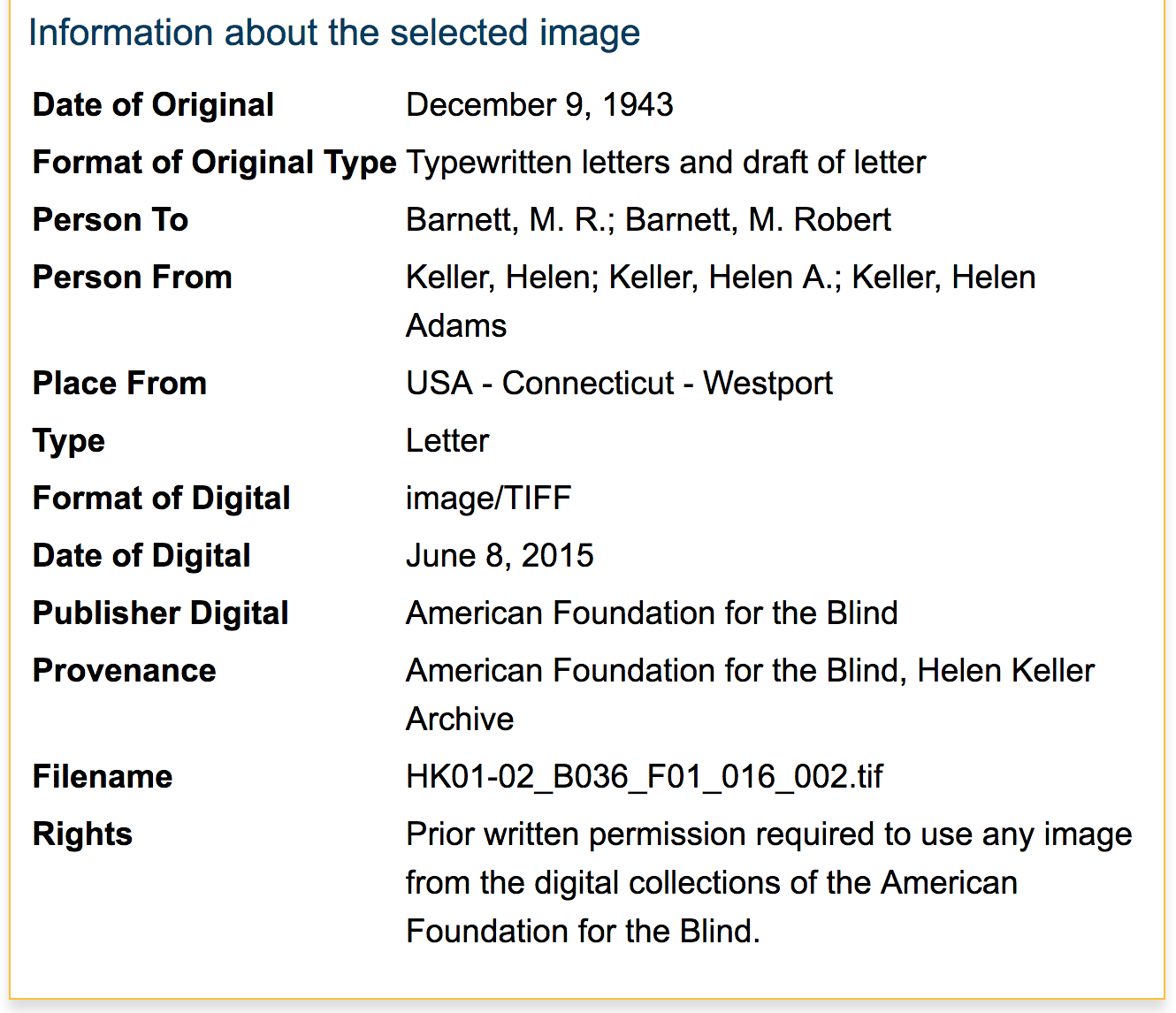Lesson Two: Primary and Secondary Sources
Before Teaching
Main Idea
A primary source is evidence of history. Whether it is an object, text, or recording, a primary source was created at the time a particular event occurred or was created by someone with firsthand knowledge of an event.
A secondary source synthesizes or analyzes primary source material. Typically, researchers produce secondary sources after an historical event or era. They discuss or interpret evidence found in primary sources. Examples are books, articles, and documentaries.
Overview
Using materials from the Helen Keller Archive, students learn to identify and use primary sources in their research and historical writing. Students differentiate between primary and secondary sources and critically examine the authorship, purpose, and historical context of multiple primary sources.
Learning Objectives
- Define and differentiate between primary and secondary sources.
- Examine and analyze the contents of primary sources.
Guiding Questions
- What is a primary source?
- What is a secondary source?
- Where do I find primary sources?
- How do I read a primary source?
Materials
- Computer/tablet/laptop
- Internet connection
- Projector or Smartboard (if available)
- Worksheets (provided, print for students)
- Pen/Pencil/Paper
Time
45 minutes
Resources
Screenshots


Websites
Helen Keller Archive | https://www.afb.org/HelenKellerArchive
American Foundation for the Blind | http://www.afb.org
Lesson Plan
Part 1: What is a Primary Source?
Ask and Discuss:
- Does anyone keep a diary? Write texts? Take photos? Create art?
- If a historian found your diary/emails/photos 100 years from now, what would they learn about your life? Family? School? Town?
- For example, in an archaeological dig, researchers might uncover your local landfill, including the empty toothpaste tube you threw out last week. Looking through an archive, a researcher might find my gradebook from this very year…including your last test score.
- These everyday products of your life are potentially primary sources. Historians use items like these from ten, a hundred, a thousand years ago to learn about the past.
Explain and Connect:
A Primary Source …
- Was created in the past, specifically at the time being researched.
- But just being “old” does not make something a primary source.
- Has firsthand knowledge or other direct evidence of the era or subject under research.
- Has provenance. Provenance means that the time and/or place of the production of a document or artifact can be reasonably believed to be true and provable.
- Needs to be evaluated based on its creators (who made it) and historical context (when and how it exists).
- Is found in an archive, museum, library/bookstore, or maybe in your backpack, right now.
- Define archive for students if necessary. See Definitions page.
- Explain that if your texts and videos are preserved, for example in an archive, library, or museum, scholars in the future may use your work to write a history of the early 21st century.
- Look at your last text conversation/email thread/search history. What could it show a historian about life in the 21st century?
Compare sources side-by-side, using worksheet at the end of this lesson plan.
- Read sources as a class.
- What is similar about these two sources? Different?
- Both of these documents are about Helen Keller and her advocacy. One was written 100+ years later by a historian, and one was written by Helen herself.
- The letter is a primary source.
- The biography is a secondary source.
A secondary source…
- Was written after the time under research.
- Brings together primary source material to tell a larger story.
- Some sources can be either a primary or secondary source, depending on how it is used.
- For example: if someone in the 19th century is writing about the 17th century, that source is a secondary source for the 17th century and a primary source for the 19th century.
- Is found in classrooms, libraries/bookstores, movies, or new media.
Brainstorm Examples of Primary and Secondary Sources
Optional: Which of the following are primary sources? Secondary? Both?
- Your history textbook
- A diary written in 1940
- Leonardo’s The Last Supper
- A documentary on the life of Helen Keller
- Tax records
- A photograph of the attack on Pearl Harbor during World War II
- A musical about American history
- A history of the Roman Empire written in 1776
- Yesterday’s newspaper
Part 2: How Do I Use Primary Sources?
Demonstrate:
- Pull up the digital Helen Keller Archive.
- Explain that the class will be using primary sources found in the HKA, which collects documents and objects by and about Helen Keller.
- Navigate to primary source used in earlier exercise:
- Detail that this letter is preserved in material/physical format at the Helen Keller Archive facility.
Let’s Find Out More About this Primary Source.
- Explain that a digital archive includes metadata/source information that will allow researchers to analyze and contextualize the source.
- Highlight the Metadata section and explain the information available in metadata, including description, subject, date, original type, person to/from, place.
- This metadata tells us the 5W1Hs of the primary source: who, what, when, where, why, and how.
- Highlight transcript section and explain that archivists and volunteers transcribe any text found in the document.
Transcription is important because:
- It helps us read unfamiliar handwriting or faded letters.
- It helps people with visual impairment use text-to-speech technology to read documents.
Ask and Discuss
- To analyze a primary source, start with the basics: Who, what, when, where, why, and how.
- Who wrote this letter? When?
- To what is the letter responding?
- What does the author say about the topic under consideration? What alternatives do they propose?
- What names or terms in this letter are unfamiliar? What additional information would you need to more fully understand this letter?
- Based on this letter, what can we infer about the economic position of blind Americans in the 1940s?
- Let’s refer back to the secondary source.
- Where does the author of the secondary source refer to the letter?
- How does she use the letter to prove a point? What is she trying to prove?
- What additional information does she provide to contextualize this letter?
– OR –
Activity
Students complete “Spotlight on Helen Keller” individually or in groups.
Activities
Homework: Using Primary Sources
(Downloadable PDF of Homework: using Primary Sources)
Worksheet: Comparing Sources
(Downloadable PDF of Worksheet: Comparing Sources
Activity: Be the Historian (for students)
(Downloadable PDF of Activity: Be the Historian for students)
Activity: Be the Historian (for teachers)
(Downloadable PDF of Activity: Be the Historian for teachers)
Curriculum Standards
This Lesson Meets Curriculum Standards:
Common Core
CCSS.ELA-LITERACY.RH.6-8.1
Cite specific textual evidence to support analysis of primary and secondary sources.
CCSS.ELA-LITERACY.RH.6-8.2
Determine the central ideas or information of a primary or secondary source; provide an accurate summary of the source distinct from prior knowledge or opinions.
CCSS.ELA-LITERACY.RH.6-8.6
Identify aspects of a text that reveal an author’s point of view or purpose (e.g., loaded language, inclusion or avoidance of particular facts).
CCSS.ELA-LITERACY.RH.6-8.9
Analyze the relationship between a primary and secondary source on the same topic.
CCSS.ELA-LITERACY.W.7.8
Gather relevant information from multiple print and digital sources, using search terms effectively; assess the credibility and accuracy of each source; and quote or paraphrase the data and conclusions of others while avoiding plagiarism and following a standard format for citation.